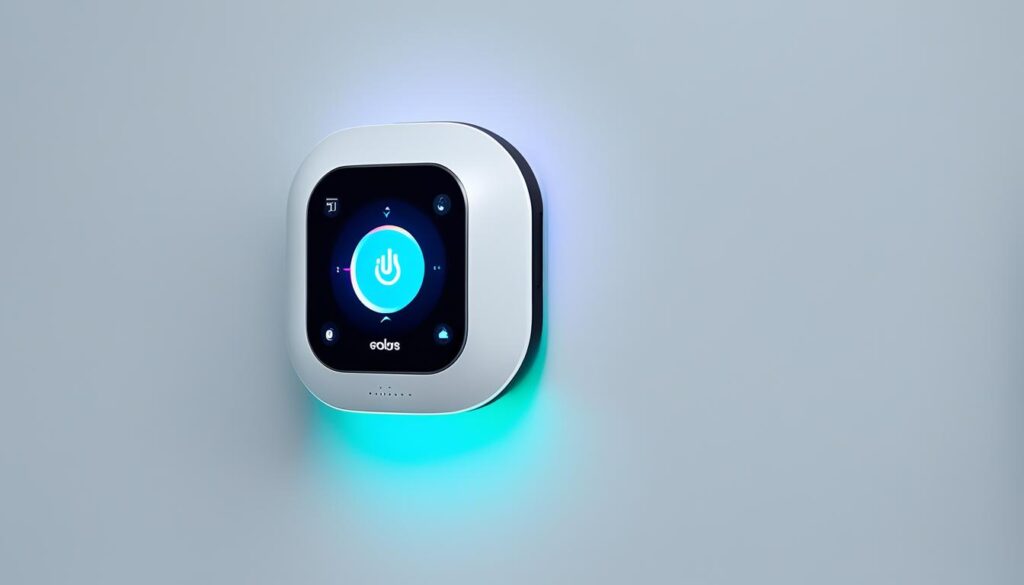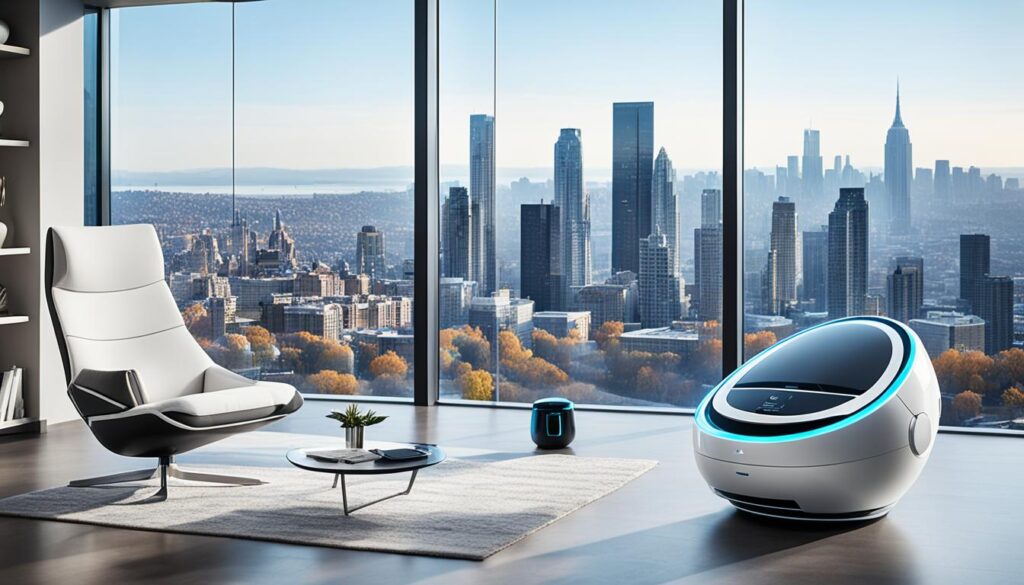Smart home technology keeps getting better. It’s important to know the latest trends. These can make your home even more amazing. The smart home market’s size was $80 billion in 2022. It could reach $338 billion by 2030. This growth is pretty big.1 The U.S. might have 69.91 million smart homes in 2024. This shows more and more people are getting into smart tech.1
In 2024, smart homes will see some cool new things. There will be better home security. Living sustainably will be easier. You could control things by talking or moving your hands. Health monitoring will be more natural. Stuff in your home will get to know you better. Smart gadgets and robots will be everywhere. They’ll help with daily tasks. Appliances will be quieter. They’ll also be smarter thanks to connections with smart cities.
Key Takeaways
- The global smart home market is projected to grow significantly, reaching $338 billion by 2030.
- The number of smart homes in the U.S. is expected to increase to 69.91 million by 2024.
- Smart home trends will focus on advanced security, sustainable living, voice and gesture control, health monitoring, and AI-driven personalization.
- Smart appliances and robotics will become more prevalent, with autonomous features and increased integration.
- Quiet appliances and smart home integration with smart cities will enhance comfort and efficiency.
Advanced Home Security
Many people put security first, especially in smart homes. By 2024, we’ll see facial recognition and motion sensors getting even better. This tech will tell apart family, guests, and strangers without invading privacy.2 Thanks to AI and machine learning, these systems work better and have fewer false alarms. They offer tailored safety for each user.2
Facial Recognition and Motion Sensing
Top home gadgets include outdoor security cameras and video doorbells. They can tell if it’s a person or a pet moving around.2 More and more, facial recognition cameras are used at home. They help control who gets in, making sure only the right people have access.2
Smart Home Security Gadgets
Smart technologies aim to keep your home secure.2 Now, you can use your voice to control safety systems thanks to Alexa and Google Home. These work with your security devices for better protection.2 Using your fingerprint or face to unlock doors is getting popular. It’s safer than using keys or codes.2
Vivint Smart Home
For top-notch security, consider a Vivint Smart Home system. It’s professionally monitored, giving you the best protection.2 Their wireless devices make setting up easy and offer great communication between them.2
ADT Command
The ADT Command system is another great choice. It combines many smart features for your home’s safety.2 More homes now use automatic gates for better security and easy control from afar.2
Ring
Ring is a favorite among homeowners for smart security. Their devices work together to keep your home safe.2 You can control these devices from anywhere, ensuring your home is always watched over.2
Arlo Security System
The Arlo Security System is known for its strong protection. It connects cameras, sensors, and smart features seamlessly.2 It also checks for important warnings like smoke or water leaks, making your response to emergencies fast.2
Sustainable Living
Smart homes are becoming more eco-friendly. They now feature energy-saving appliances, smart thermostats, and solar power. These changes help cut down on both our pollution and our bills.1 Energy-efficient homes sell for 2.7% more than similar ones without green upgrades. This shows the financial value of eco-friendly choices.1
Energy-Efficient Appliances
Choosing energy-efficient appliances is crucial for green homes. These products use less power, which means lower energy bills.1 By 2024, more people will want appliances that are not just efficient but also quiet. This trend means we might see less noisy homes in the future.1
Smart Thermostats
Smart thermostats are vital for sustainable living. They can adjust the temperature automatically or be controlled from afar.3 They also use data to find what’s using the most energy in your home. This can help you decrease waste and prevent accidents like fires or floods.3
Solar Power Systems
Green homes often use solar panels and wind turbines. These devices can make a home more self-sufficient in terms of energy.3 Plus, AI can fine-tune how the energy is used based on the moment’s needs. This makes everything from lights to heating more efficient.3
Benefits of Sustainable Living
Choosing a sustainable lifestyle can be rewarding in many ways. It saves money on energy bills, helps the environment, and increases home value.1 Plus, you can get great tax breaks. For example, upgrading to an energy-efficient home can save you up to $1,200.1 With clean energy tech, you might cut your tax bill by up to 30%.1
Reduced Energy Bills
Living sustainably in a smart home means spending less on energy. Appliances, thermostats, and solar panels help lower your bills. This leads to big savings over time.1
Environmental Impact
Embracing green tech has a big impact on our planet. It cuts down on energy use and promotes clean energy. This reduces our carbon footprint for a better tomorrow.4 Changing to electric delivery trucks can also help, since they decrease the pollution from shipping.4
Increased Home Value
Making your home more sustainable can raise its selling price. On average, greener homes sell for 2.7% more than less efficient ones.1 This means that not only does it save you money, but it can also make your property more valuable.1
Comfort and Health
Green smart homes can make life better and healthier. They use technology to improve air quality and spot allergens. This means a cozier and safer place to live.3
Tax Incentives
There are several tax benefits for making your home green. You could see yearly savings up to $3,200 for being more energy efficient.1 Also, upgrades in energy efficiency or clean energy can lower your tax bill significantly.1

Smart Home Trends
The smart home world is always changing. It gives homeowners new ways to make their living spaces better. This year, we’ll see big changes.5
Now, homes can tell who’s who with facial recognition and motion sensors. This makes them safer. Other than safety, homes will focus on being good for the planet. You’ll find energy-saving gadgets and green power systems. These help cut down on waste and save money.5
More things in our homes will talk to each other because of the IoT. For example, a fridge might tell your phone what it needs from the store. Or, an oven might start heating up when it knows you’re almost home. This makes smart homes even more helpful and smart.5
Doing things with just your voice or a wave will soon be very common. This means you can make your home do what you want without touching anything.5 Devices will also keep an eye on your health, like your heart rate. They will make sure the air you breathe is clean. This is for a healthier place to live.5
Home entertainment will get a big upgrade with virtual and augmented reality. This is great for games, movies, and staying fit.5 AI will also make homes better because it learns your habits. It can adjust the lights and temperature just how you like them.5
Appliances will get smarter too. A fridge might order food by itself, and a washing machine can pick the best wash cycle.5 Homes will also become easier to change. You can redesign with moving walls and special materials.5
Smart homes won’t just be isolated. They will work with smart cities. This will help with traffic, energy, and emergencies. It’s all about making city life better.5
In 2024, smart homes will do more for us than ever. They’ll blend ease with safety and green living. Homeowners will find these changes very helpful. Their homes will be more in tune with their daily lives. This will make life better and more fun.516
Voice and Gesture Control
In 2023, an estimated 146 million Americans will have access to voice assistants1. By 2024, these systems will better understand how we talk. This means we can use our voices more naturally to control things. Also, gesture control is becoming more popular. It lets us use hand movements to interact with our smart devices.7
Intuitive Voice Control Systems
Imagine turning on lights or setting the temperature by just saying it. Smart homes are making this possible. They let us control various features using just our voice. For example, you can manage your energy use, keep your hands free, and get personalized services.8
Gesture Control
Controlling things with hand movements is an exciting feature in smart homes. This system interprets simple gestures as instructions. It’s smart and safe, using special technology to understand what we want to do.7 With gesture control, you don’t have to touch your devices. This makes things easier and more people can use them.7
Popular Voice Assistants
Big voice assistants like Amazon Alexa and Google Assistant are getting smarter. They’re using more AI to improve how they help us at home. We’ll likely see more voice and gesture controls in many smart devices soon. The smart home world is changing fast.1

Health Monitoring
Smart homes are becoming key in health care. They connect with wearables, which in turn communicate with health systems. This lets them keep an eye on our vital signs. They can even alert doctors when we need help.1 They also watch over our air quality, checking for things that could make us sick. This makes sure our homes are safe places to live.
Wearables and Home Systems Integration
Health begins at home with smart technology. For example, air quality sensors can measure the air for safety. They find allergens and alert us to open windows or change filters.1 Beds that are smart can observe our sleep habits. They give us tips for better sleep. Plus, smart kitchen appliances follow what we eat. They recommend dishes that fit our health goals.
Air Quality and Allergen Tracking
Smart devices are making a big difference in how we look after our health, especially for older people.9 These gadgets track everything from air quality to how soundly we sleep. They provide insights that help us keep our home a healthy place.9
AI-Driven Personalization
For years, smart homes have changed how we live. Now, Artificial Intelligence (AI) is stepping into our lives in new ways. It’s not just about following our commands. AI is creating spaces that meet our needs even before we ask.10
Holistic Home Ecosystems
Smart home tech is growing. It’s connecting more devices to make our lives easier and more personal. AI will mix efficiency with personal touches in our homes. This will mean homes that know our habits and likes, creating a complete living experience.10
Real-Time Adaptation
Soon, AI in our homes will react as soon as we come in. It will change the house to fit us, adjusting lights, music, and more. This will blend everything together for a home that feels just right for us.10
Complex Routines Made Simple
AI will make our daily lives simpler. It will learn what we need and do things for us. From managing energy to watching over our safety, it will make things run more smoothly.10
Anticipatory Technology
Soon, our smart homes will even predict our needs. These smart systems will get to know our daily habits. Then, they’ll change the home space to make things easier and more comfortable for us.10
AI is changing how we feel at home by adjusting to what makes us unique.10

Smart Appliances and Robotics
The smart home market is growing fast. Smart appliances are becoming more independent, and robots are joining our lives. The House of Robots exhibit at a big tech show in Europe showed how robots can do many jobs in different fields.5
Autonomous Appliances
In the future, smart appliances will need less from us. Robots that vacuum and mow are already here. They connect online to make maps of our homes, which helps them work better.5
Soon, robots will do even more tasks, saving us time. They will get better with new technology, becoming more efficient.5
Domestic Robots
Robots are now a big part of our home life. They do cleaning, cooking, and even take care of pets. These robots use the internet to navigate and work precisely.5
As smart home tech grows, we’ll see more of these helpful robots in our homes. This will make daily chores easier, giving us a more efficient smart home.5
Quiet Appliances
Quiet appliances are key for today’s living. The noise from fridges and washing machines can disturb a home’s peace. The outlook for 2024 says more people will want [quiet appliances]. These let them keep their home’s tranquility.
In 2024, fridges and washers will be quieter. This makes home life more serene without losing appliance function. The move to [quiet appliances] fits with wanting smart, energy-efficient tech. It helps make life better.
The newest quiet appliances make homes more peaceful. This trend in quieter tech boosts comfort and well-being. It also makes for a more relaxing space. Families can enjoy smart homes fully.

Integration with Smart Cities
The future of smart homes is closely linked to smart cities. Smart homes will connect with smart city systems. This will make urban life more connected and efficient.11
Smart homes will share data with the city. This allows for better urban management. They can help improve traffic by sharing data on cars and how full they are.11 Also, connecting smart homes to city energy systems can save energy, use it better, and help the environment.11
Linking smart homes with city systems can also speed up emergency responses. If a smart home notices something wrong, it can quickly alert the right authorities. This makes dealing with problems like fires or medical needs faster and smoother.11
As integration with smart cities moves forward, living gets easier. Smart homes and cities working together make life more connected and responsive. This helps everyone in the city enjoy a better quality of life.11

Conclusion
In 2024, smart homes are set to become even more amazing. They will offer an integrated, intelligent, and responsive living space. This change will combine convenience with security and green living. Over 57% of US homes will have a smart device by 2025,12 and about 75% will use a voice assistant to manage things12.
As tech gets better, our homes get smarter and meet our needs. The number of IoT gadgets went up 18% last year, hitting over 14 billion12. There’s a 16% expected growth this year to 16.7 billion endpoints12. This shows how fast we’re adding smart devices to our lives.
Smart home gadgets are also becoming more affordable around Europe, with prices dropping 14%. By 2026, we expect smart features to come as standard in most big appliances12. This means a smarter and more energy-savvy home for many. As we welcome new tech into our homes, we aim for spaces that are not just smart but better suited to us, our habits, and the planet.
FAQ
What is the current size and projected growth of the global smart home market?
The global smart home market was Billion in 2022. It’s expected to hit 8 billion by 2030. The growth hints at their value for home improvement and efficiency.
How many smart homes are estimated in the United States by 2024?
By 2024, the US will have about 69.91 million smart homes. This data comes from a Statista study.
What are the top smart home trends expected in 2024?
2024’s smart home trends will include better home security and green living. They’ll also feature voice and gesture control, health monitoring, and AI customization.
What advanced security features are expected in smart homes in 2024?
Expect to see high-tech face and motion recognition in 2024. This tech will sort out who’s who without invading privacy. Outdoors cameras, doorbells, and smart locks will be key.
What smart home security systems are recommended for maximum protection?
Top protection might mean going with pros like Vivint Smart Home or ADT. Other options include Ring and Arlo for solid security.
How are smart homes becoming more energy-efficient and sustainable?
Green smart homes will use eco-friendly appliances, smart thermostats, and solar power. These help cut down on bills and benefit the environment. Plus, they can earn you tax savings.
How are voice assistants and gesture control becoming more prevalent in smart homes?
By 2024, voice control will get even better at understanding us. Gestures will also offer a neat way to engage with smart tech. AI-backed assistants like Alexa and Google are getting smarter.
How can smart homes monitor health and improve living environments?
Smart homes will keep an eye on health by tracking vitals and the environment. They help ensure a safe and healthy living space. Smart beds and appliances will also give health tips.
How is AI revolutionizing smart home technology?
AI is changing smart homes from just following orders to anticipating our needs. It’s making homes more efficient and personalized. AI promises smarter and more tailored home experiences.
How are smart appliances and robots becoming more integrated into our homes?
Soon, smart appliances will work more on their own. Robots are also finding more use in our living spaces. They learn as they go, making them more helpful.
What is the trend towards quieter appliances in smart homes?
By 2024, people will prefer appliances that operate quietly. This move is away from the loud noises of traditional home gadgets.
How will smart homes integrate with the broader infrastructure of smart cities?
Smart homes will mesh with smart city plans. They’ll share data to enhance traffic, save energy, and boost emergency responses. This will make urban living smarter and smoother.
Source Links
- https://raleighrealtyhomes.com/blog/smart-home-trends/
- https://www.arrowheadgrp.com/blog/latest-home-security-trends/
- https://www.control4.com/blog/641/smart-homes-are-sustainable-homes/
- https://www.jabil.com/blog/smart-home-sustainability.html
- https://us.sengled.com/blogs/blog/10-smart-home-trends-2024
- https://www.idealhome.co.uk/house-manual/smart-home/smart-home-ideas-and-trends
- https://nexasmarthome.com/gesture-control-in-smart-homes-the-future-interface/
- https://www.linkedin.com/pulse/impact-voice-enabled-technology-smart-home-applications-syndell-vlncf
- https://www.ncbi.nlm.nih.gov/pmc/articles/PMC10141305/
- https://inoxoft.com/blog/how-to-use-ai-for-smart-home-technology/
- https://race.com/blog/smart-home-trends/
- https://blog.switch-bot.com/smart-home-market-trends-and-predictions-you-should-know/
